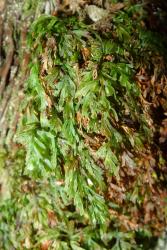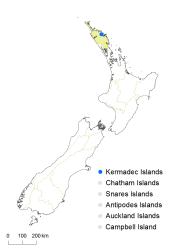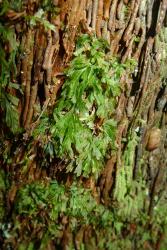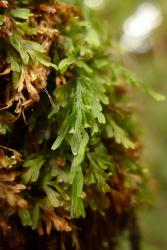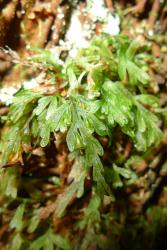- ≡ Macroglena caudata (Brack.) Copel., Philipp. J. Sci. 67: 84 (1838)
- ≡ Cephalomanes caudatum (Brack.) Bostock in Bostock & Spokes, Fl. Austral. 48, 706 (1998)
- ≡ Abrodictyum caudatum (Brack.) Ebihara & K.Iwats. in Ebihara et al., Blumea 51: 243 (2006)
Epiphytic ferns. Rhizomes short to long-creeping, c. 0.5 mm diameter, bearing red-brown hairs up to 2 mm long. Fronds 18–65 mm long. Stipes 2–20 mm long, brown, not winged or with a very narrow wing distally, glabrous or with short scattered hairs. Laminae 1–3-pinnatifid, elliptic or ovate or narrowly ovate, 12–50 mm long, 8–16 mm wide, green, membranous, glabrous or with very short scattered hairs on veins. Rachises narrowly winged throughout, brown or becoming green distally, glabrous or with very short scattered hairs. Primary pinnae in 2–10 pairs, not overlapping, narrowly ovate to broadly ovate, winged throughout; distal primary pinnae adnate; proximal primary pinnae almost stalked; the longest primary pinnae at or below the middle, 5–10 mm long, 2–8 mm wide. Ultimate segments linear, entire, up to 4 mm long, 0.4–0.8 mm wide, adnate, each with a single unbranched vein; apices obtuse; margins entire with a clearly defined border of shorter cells with transverse end-walls. Sori borne on short acroscopic segments near bases of primary pinnae, one on each primary pinna, adnate; indusia campanulate, 1–1.5 mm long, widened at mouth; sporangia borne on a fine receptacle up to 6 mm long, projecting well beyond the indusia at maturity.
Trichomanes caudatum is distinguished from T. elongatum and T. strictum by its epiphytic habit, creeping rhizome, lamina segments with a clearly defined border, and campanulate indusia which are widened at the mouth. It is superficially similar to, and occupies the same habitat as, T. venosum, but can be distinguished by its bordered lamina segments, obtuse apices which are never emarginate, and ultimate lamina segments with a single unbranched vein. It is also superficially similar to T. humile but can be distinguished by the unistratose border of short cells with transverse end-walls.
North Island: Northland.
Kermadec Islands.
Altitudinal range: 10–20 m (Northland), c. 450 m (Raoul Island).
Trichomanes caudatum is a rare fern in New Zealand, known only from Raoul Island, Kermadec Islands, and from near Kerikeri in Northland.
Also Australia (Queensland, New South Wales, Victoria), New Caledonia, Fiji, Samoa, Cook Islands, Society Islands.
Occurs as an epiphyte on Dicksonia squarrosa in lowland podocarp and broadleaved forest on a river terrace near Kerikeri, and on massive trunks of Cyathea milnei in wet Metrosideros forest at c. 450 m on Raoul Island.
Trichomanes caudatum (as Abrodictyum) from the Kermadec Islands was given a conservation status of Naturally Uncommon by de Lange et al. (2013), but they treated the Kerikeri population as a separate indeterminate taxon, "Abrodictyum aff. caudatum", which was listed as Nationally Critical.
In the classification of Ebihara et al. (2006), Trichomanes caudatum is treated as Abrodictyum caudatum.
There are differences between the Kerikeri and Raoul plants. The fronds of the Kerikeri plants grow downwards against the substrate, whereas Raoul plants appear slightly more upright. The indusia are more obviously flared in the Kerikeri plants, whereas the very few present in the Raoul material appear to be more truncate. Also the plants on Raoul grow at a much higher altitude than those at Kerikeri. Whether the two populations belong to the same species is uncertain.
Fronds of Trichomanes caudatum in New Zealand are much smaller and less divided than those in Australia or the Pacific. Nevertheless the cell structure of the lamina and the shape of the indusia suggest that they are correctly referred to this species. In Northland, the species is on the very southern edge of its distribution and the plants are probably poorly developed compared to those in tropical regions. DNA sequencing (Perrie et al. 2016) indicates that the Kerikeri plants group with those in Fiji, French Polynesia, and Australia. However, it also indicates that New Caledonian material of T. caudatum is different to that in Fiji, French Polynesia, and Australia, suggesting that more than one species may be present in the Pacific region.



